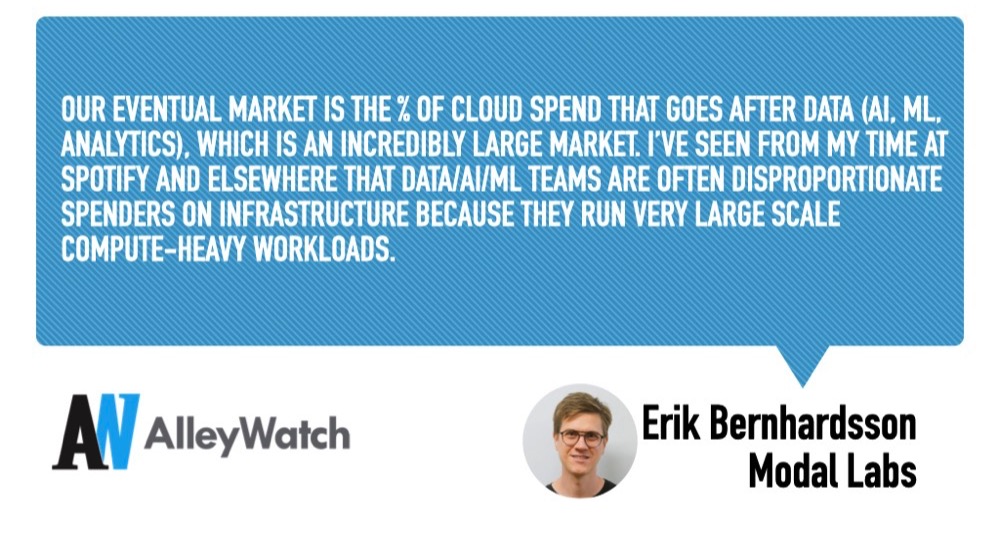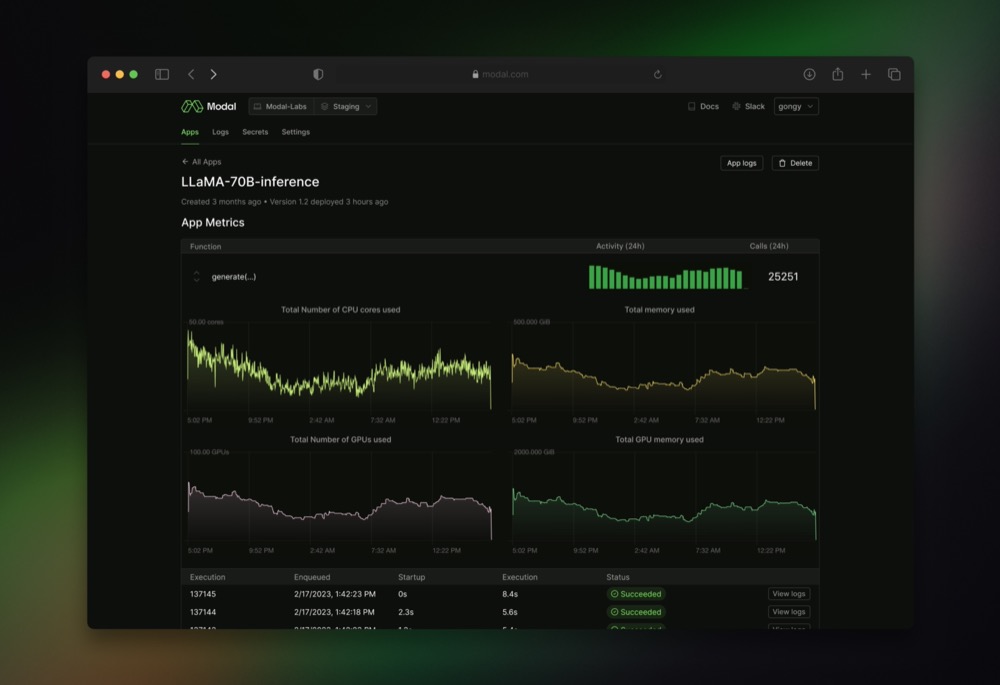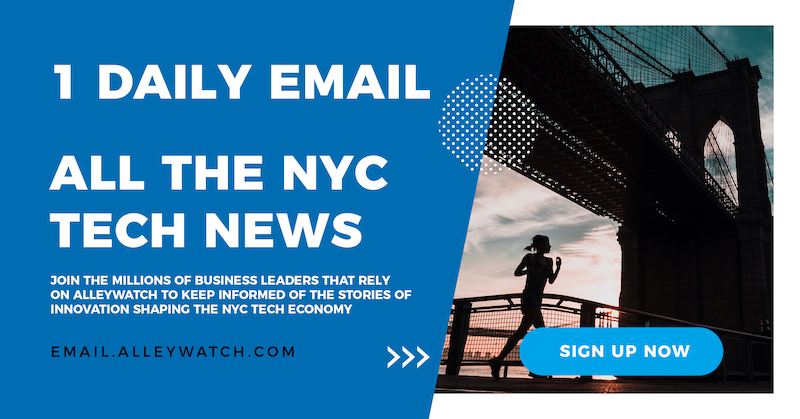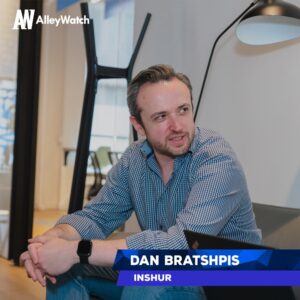The backbone of any AI project comes down to the hardware, software, and networking components that allow engineers and data teams to develop, deploy, and manage AI projects. While economic challenges are forecasted for the next few years with companies cutting expenses across the board, spending on cloud infrastructure is actually expected to increase 70% to just under $1T per year by 2025; much of this is fueled by companies looking to harness the power of AI. Modal Labs is a data infrastructure platform built specifically for the cloud to power AI applications. The platform offers containerized solutions that allow developers to launch the infrastructure for AI solutions in seconds rather than having to integrate disparate solutions, saving time and ultimately money. The company hosts the entire infrastructure, offers automated scaling to different GPUs and CPUs, and charges per second actual usage similar to cloud providers like AWS and Google Cloud. Modal is versatile enough to handle a wide variety of use cases such as generative AI, computational biotech, automated transcription, and code execution.
AlleyWatch caught up with Modal Labs CEO Erik Bernhardsson to learn more about the business, the company’s strategic plans, latest round of funding, which bring the company’s total funding raised to $23M, and much, much more…
Who were your investors and how much did you raise?
Series A, raising $16M led by Redpoint. Amplify who led our seed also invested more.
Tell us about the product or service that Modal Labs offers.
Modal offers data infrastructure in the cloud. A lot of customers use us in production for various types of Generative AI applications, doing serverless GPU-based inference. But we also have a lot of other use cases, such as computational biotech, media processing, et cetera.
What inspired the start of Modal Labs?
 I spent most of my career working on data products, in particular, I was at Spotify for 7 years building the music recommendation system. I saw a gap in the market for infrastructure tools for data teams.
I spent most of my career working on data products, in particular, I was at Spotify for 7 years building the music recommendation system. I saw a gap in the market for infrastructure tools for data teams.
How is Modal Labs different?
We realized very early that in order to deliver the best developer experience, we would have to go very deep into the underlying layers and rewrite almost everything. So we built most of the infrastructure ourselves, including a custom file system and container engine. The upside is we the ability to launch containers in the cloud in seconds, offering a much better user experience than any other tool previously.
What market does Modal Labs target and how big is it?
Our eventual market is the % of cloud spend that goes after data (AI, ML, analytics), which is an incredibly large market. I’ve seen from my time at Spotify and elsewhere that data/AI/ML teams are often disproportionate spenders on infrastructure because they run very large scale compute-heavy workloads.

What’s your business model?
We run things in the cloud and have a usage-based pricing model, similar to cloud vendors like AWS (e.g. their EC2 and Lambda products).
How are you preparing for a potential economic slowdown?
The cloud market and the AI markets are growing extremely quickly, which mostly offsets any slowdown in the greater economy.
What was the funding process like?
We had a competitive process with several exciting potential VCs to partner with. We chose Redpoint primarily because they have a long history investing in infrastructure and data.
What are the biggest challenges that you faced while raising capital?
We had some concerns in 2022 when the fundraising market cooled down, but honestly in 2023 the excitement around AI was more than enough to offset that, creating a lot of inbound interest for investing in Modal.

What factors about your business led your investors to write the check?
We have a strong team of experienced engineers, many with successful programming competition background. It’s a very large market. And we had a lot of early users talking about the product on Twitter and elsewhere.
What are the milestones you plan to achieve in the next six months?
Grow revenue and launch features that help us go after the enterprise market.
What advice can you offer companies in New York that do not have a fresh injection of capital in the bank?
Don’t be afraid to go deep and rethink a lot of core foundational layers. Focus on some revenue early (can be $1) – people’s willingness to pay proves that you’re on the right track.
Where do you see the company going now over the near term?
We want to be a general-purpose compute platform and rethink a large part of the entire data stack.
What’s your favorite fall destination in and around the city?
Hudson Valley.
You are seconds away from signing up for the hottest list in Tech!
Sign up today
- SEO Powered Content & PR Distribution. Get Amplified Today.
- PlatoData.Network Vertical Generative Ai. Empower Yourself. Access Here.
- PlatoAiStream. Web3 Intelligence. Knowledge Amplified. Access Here.
- PlatoESG. Carbon, CleanTech, Energy, Environment, Solar, Waste Management. Access Here.
- PlatoHealth. Biotech and Clinical Trials Intelligence. Access Here.
- Source: https://www.alleywatch.com/2023/10/modal-labs-serveless-data-infrastructure-cloud-generative-ai-platform-erik-bernhardsson/
- :is
- :not
- $UP
- 001
- 2022
- 2023
- 2025
- 300
- 7
- a
- ability
- About
- Achieve
- across
- actual
- actually
- advice
- afraid
- After
- AI
- allow
- Allowing
- almost
- also
- an
- analytics
- and
- Another
- any
- applications
- ARE
- around
- AS
- At
- Automated
- away
- AWS
- Backbone
- background
- Bank
- BE
- because
- BEST
- Better
- Big
- Biggest
- biotech
- board
- bring
- Building
- built
- business
- business model
- but
- by
- CAN
- capital
- Career
- cases
- ceo
- cetera
- challenges
- charges
- check
- chose
- City
- Cloud
- cloud infrastructure
- code
- COM
- comes
- Companies
- company
- Company’s
- competition
- competitive
- components
- computational
- Compute
- Concerns
- Container
- Containers
- Core
- Creating
- custom
- Customers
- cutting
- data
- data infrastructure
- deep
- deliver
- deploy
- destination
- develop
- Developer
- developers
- DID
- different
- disparate
- disproportionate
- do
- does
- doing
- down
- e
- E&T
- Early
- Economic
- economy
- elsewhere
- Engine
- Engineers
- enough
- Enterprise
- Entire
- eventual
- everything
- Excitement
- exciting
- execution
- expected
- expenses
- experience
- experienced
- extremely
- faced
- factors
- Fall
- Favorite
- Features
- few
- File
- Focus
- For
- fresh
- from
- fueled
- funding
- Fundraising
- gap
- general-purpose
- generative
- Generative AI
- Go
- Goes
- going
- Google Cloud
- GPUs
- greater
- Growing
- had
- handle
- Hardware
- harness
- Have
- having
- help
- history
- Honestly
- hosts
- hottest
- How
- HTTPS
- i
- in
- Including
- Increase
- incredibly
- Infrastructure
- inspired
- integrate
- interest
- into
- invested
- investing
- Investors
- IT
- jpg
- just
- Labs
- large
- latest
- launch
- layers
- LEARN
- Led
- like
- List
- Long
- looking
- Lot
- manage
- many
- Market
- Markets
- max-width
- Media
- Milestones
- ML
- model
- money
- months
- more
- most
- mostly
- much
- Music
- my
- Near
- networking
- New
- New York
- next
- now
- of
- offer
- offering
- Offers
- offset
- offsets
- often
- on
- or
- order
- Other
- our
- ourselves
- over
- part
- particular
- partner
- Pay
- people’s
- per
- plan
- plans
- platform
- plato
- Plato Data Intelligence
- PlatoData
- potential
- power
- preparing
- previously
- pricing
- pricing model
- primarily
- process
- processing
- Product
- Production
- Products
- Programming
- project
- projects
- proves
- providers
- quickly
- raise
- raised
- raises
- raising
- raising capital
- rather
- realized
- Recommendation
- Redpoint
- revenue
- right
- round
- Run
- saving
- saw
- Scale
- scaling
- Second
- seconds
- see
- seed
- seen
- Serverless
- service
- several
- signing
- similar
- SIX
- Six months
- Slowdown
- So
- Software
- Solutions
- some
- specifically
- spend
- Spending
- spent
- Spotify
- stack
- start
- Strategic
- strong
- successful
- such
- system
- talking
- Target
- team
- teams
- term
- than
- that
- The
- their
- they
- things
- this
- time
- to
- tool
- tools
- Total
- track
- types
- Ultimately
- under
- underlying
- Upside
- us
- Usage
- use
- User
- User Experience
- users
- Valley
- variety
- various
- VCs
- vendors
- versatile
- very
- want
- was
- we
- were
- when
- which
- while
- wide
- Willingness
- with
- working
- would
- write
- year
- years
- york
- you
- Your
- zephyrnet













